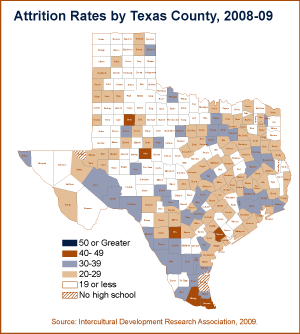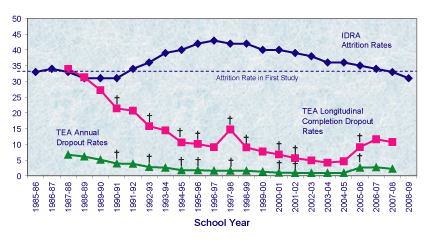• By Roy L. Johnson, M.S. • IDRA Newsletter • October 2009
 In its most recent annual attrition study that examines school holding power in Texas public high schools, IDRA found that 31 percent of the freshman class of 2005-06 left school prior to graduating from a Texas public high school in the 2008-09 school year. The current statewide attrition rate in Texas is 6 percent lower than the initial rate of 33 percent found in IDRA’s landmark 1985-86 study.
In its most recent annual attrition study that examines school holding power in Texas public high schools, IDRA found that 31 percent of the freshman class of 2005-06 left school prior to graduating from a Texas public high school in the 2008-09 school year. The current statewide attrition rate in Texas is 6 percent lower than the initial rate of 33 percent found in IDRA’s landmark 1985-86 study.
This latest finding suggests that the ability of Texas public high schools to keep students in school until they graduate has improved somewhat for students overall in recent years. However, the gaps between the attrition rates of White students, Hispanic students and Black students are higher than 24 years ago.
In 1985-86, the gap between the attrition rates of White students and Hispanic students was 18 percentage points (27 percent for White students and 45 percent for Hispanic students) compared to a gap of 25 percentage points in 2008-09 (17 percent for White students and 42 percent for Hispanic students). The gap between the attrition rates of White students and Black students in 1985-86 was 7 percentage points (27 percent for White students and 34 percent for Black students) compared to 18 percentage points in 2008-09 (17 percent for White students and 35 percent for Black students).
A supplemental analysis indicates that, based on one statistical scenario of Texas attrition rate history, the state will not reach an attrition rate of zero until 2042. At this pace, the state will lose an additional 2.3 million to 6 million students. (Montes, 2009)
This 2008-09 attrition study represents the 24th study conducted by IDRA and the latest in a series of reports that began in the 1985-86 school year. In 1986, IDRA conducted Texas’ first comprehensive statewide study of high school dropouts using a high school attrition formula to estimate the number and percent of students who leave school prior to graduation.
The study in 1986 was the state’s first major effort to assess the holding power of Texas public schools. This inaugural study, entitled Texas School Dropout Survey Project, was conducted under contract with the Texas Education Agency (TEA) and the then Texas Department of Community Affairs. It examined three major research questions: (1) What is the magnitude of the dropout problem in the state of Texas? (2) What is the economic impact of the dropout problem for the state? and (3) What is the nature and effectiveness of in-school and alternative out-of-school programs for dropouts in the state?
IDRA’s inaugural study found that 86,276 students had not graduated from Texas public high schools, costing the state $17 billion in forgone income, lost tax revenues, and increased job training, welfare, unemployment and criminal justice costs (Cárdenas, Robledo and Supik, 1986).
Methods
Spanning a period from 1985-86 through 2008-09, the IDRA attrition studies have provided time series data, using a consistent methodology, on the number and percent of Texas public school students who leave school prior to graduation. These studies are the only source for examining the magnitude of the dropout problem in Texas across more than two decades using consistent data. They provide information on the effectiveness and success of Texas public high schools in keeping students engaged in school until they graduate with a high school diploma.
The attrition calculations were derived from public school enrollment data in the Texas Public Education Information Management System (PEIMS). During the fall of each year, school districts are required to report information to TEA via the PEIMS for all public school students and grade levels. IDRA’s attrition studies involve an analysis of ninth-grade enrollment figures and 12th-grade enrollment figures three years later. This period represents the time span during which a student would be enrolled in high school.
IDRA collects and uses high school enrollment data from the TEA Fall Membership Survey to compute countywide and statewide attrition rates by race-ethnicity and gender. Enrollment data from special school districts (military schools, state schools and charter schools) are excluded from the analyses because they are likely to have unstable enrollments or lack a tax base for school programs.
Attrition rates are an indicator of a school’s holding power or ability to keep students enrolled in school and learning until they graduate. Along with other dropout measures, attrition rates are useful in studying the magnitude of the dropout problem and the success of schools in keeping students in school. Attrition, in its simplest form, is the rate of shrinkage in size or number. Therefore, an attrition rate is the percent change in grade level enrollment between a base year and an end year.
 Historical statewide attrition rates and numbers of students lost to attrition are categorized by race-ethnicity and by gender (see longitudinal attrition rate table, enrollment data table and longitudinal attrition rate graph). County-level data are provided on map and on attrition rate table. In addition, trend data by county are available on IDRA’s web site at www.idra.org. IDRA has included online historical county-level numbers of students lost to attrition. See box for statewide historical numbers and the graph below for historical rates. General conclusions from this year’s study follow.
Historical statewide attrition rates and numbers of students lost to attrition are categorized by race-ethnicity and by gender (see longitudinal attrition rate table, enrollment data table and longitudinal attrition rate graph). County-level data are provided on map and on attrition rate table. In addition, trend data by county are available on IDRA’s web site at www.idra.org. IDRA has included online historical county-level numbers of students lost to attrition. See box for statewide historical numbers and the graph below for historical rates. General conclusions from this year’s study follow.
Latest Study Results
About one of every three students (31 percent) from the freshman class of 2005-06 left school prior to graduating with a high school diploma. The class of 2008-09 study cohort began with 383,061 students. Of these students, 125,508 were lost from public school enrollment between the 2005-06 and 2008-09 school years (see enrollment table). Numerically, 125,508 students were lost from public high school enrollment in 2008-09 compared to 86,276 in 1985-86.
The overall attrition rate declined from 33 percent in 1985-86 to 31 percent in 2008-09. The percentage of students who left high school prior to graduation was 33 percent in 1985-86 and 31 percent in 2008-09. Over the past two decades, attrition rates have fluctuated between a low of 31 percent in 1988-89, 1989-90, and 1990-91 to a high of 43 percent in 1996-97.

The overall attrition rate was less than 40 percent in 2008-09 for the eighth time in 15 years. The current rate of 31 percent compares to 39 percent in 2001-02, 38 percent in 2002-03, 36 percent in 2003-04 and 2004-05, 35 percent in 2005-06, 34 percent in 2006-07 and 33 percent in 2007-08, respectively. After eight consecutive years of overall statewide attrition rates of 40 percent or higher between 1994-95 and 2000-01, the overall statewide attrition rate of 31 percent in 2008-09 is the lowest since a 31 percent rate in 1988-89, 1989-90, and 1990-91, and continues a downward trend over the last several years. Between 1994-95 and 2000-01, the overall attrition rate ranged from a low of 40 percent to a high of 43 percent.
The attrition rates of Hispanic students and Black students are much higher than those of White students. Hispanic students and Black students historically have had much higher attrition rates than White students. From 1985-86 to 2008-09, attrition rates of Hispanic students declined by 7 percent (from 45 percent to 42 percent). During this same period, the attrition rates of Black students increased by 3 percent (from 34 percent to 35 percent). Attrition rates of White students declined by 37 percent (from 27 percent to 17 percent). Hispanic students have higher attrition rates than either White students or Black students.
From 1985-86 to 2008-09, Native American, Asian/Pacific Islander, Hispanic and White students saw a decline in their attrition rates. Native American students had a decline of 29 percent in their attrition rates (from 45 percent to 32 percent), and Asian/Pacific Islander students had a decline of 58 percent (from 33 percent to 14 percent). The attrition rate of Asian/Pacific Islander students was the lowest among the racial/ethnic groups, while the rate for Hispanic students was the highest.
The gap between the attrition rates of White students and Black and Hispanic students is higher than 24 years ago. The gap between the attrition rates of White students and Black students has increased from 7 percentage points in 1985-86 to 18 percentage points in 2008-09. Similarly, during this time period, the gap between the attrition rates of White students and Hispanic students has increased from 18 percentage points in 1985-86 to 25 percentage points in 2008-09. The gap between the attrition rates of White students and Native American students has declined from 18 percentage points in 1985-86 to 15 percentage points in 2008-09. Asian/Pacific Islander students exhibited the greatest positive trend in the reduction of the gap in attrition rates compared to White students. In fact, rates for Asian/Pacific Islander students were 6 percentage points higher than those of White students but now are 3 percentage points lower than those of White students.
Historically, Hispanic students and Black students have comprised a large proportion of students lost by schools. For the period of 1985-86 to 2008-09, students from ethnic minority groups account for more than four-fifths (82.1 percent) of the estimated 2.9 million students lost from public high school enrollment.
Hispanic students account for 63.6 percent of the students lost to attrition. Black students account for 16.7 percent of all students lost from enrollment due to attrition over the years. White students account for 17.9 percent of students lost from high school enrollment over time. Attrition rates for White students and Asian/Pacific Islander students have been typically lower than the overall attrition rates.
The attrition rates for males have been higher than those of females. In 1985-86 and 2008-09, attrition rates for males were the same at 35 percent. Attrition rates for females declined by 16 percent from 32 percent in 1985-86 to 27 percent in 2008-09. Longitudinally, males have accounted for 58.6 percent of students lost from school enrollment, while females have accounted for 41.4 percent. In the class of 2008-09, males were 1.3 times more likely to leave school without graduating with a diploma than females.
Conclusions
Texas public schools are failing to graduate one out of every three students. Attrition rates as an indicator in a school holding power index show that the rate was 31 percent overall and near 40 percent for Black students and Hispanic students. The overall attrition rate has declined from 33 percent in 1985-86 to 31 percent in 2008-09, but the gap or disparity in attrition rates has widened between racial/ethnic groups. Though the overall attrition rate has remained under 40 percent over the last eight years, improving school holding power in Texas schools is still an imperative as many of our schools have failed to keep students in school through graduation with a high school diploma. The number of students lost from public school enrollment has increased from 86,276 in 1985-86 to 125,508 in 2008-09.
IDRA is working on a number of efforts to improve school holding power through its collaboration with schools and communities in Texas and other parts of the country. One of these efforts is called “Graduation Guaranteed/Graduación Garantizada” which emphasizes the accountability of the school in keeping students in school until they graduate with a high school diploma. This initiative includes a School Holding Power Portal that contains dropout data that neighborhoods at the local level can use to know what is going on and take action around the issue. Another of IDRA’s efforts to improve school holding power is the dissemination of the Graduation for All e-newsletter, which provides up-to-date information on dropouts and actions to improve school holding power (sign up free).
School holding power is an important indicator of a school’s success and the quality of its educational services to students. In order to stem the tide of increasing racial and ethnic disparities in the rate of students who leave school prior to graduating with a high school diploma, school-community action teams must examine and address quality school indictors that impact the outcomes of the diverse Texas student population. In an article entitled “Holding On to the Goal of Quality Education for Every Child” in the September 2009 issue of the IDRA Newsletter, Dr. Maria “Cuca” Robledo Montecel, IDRA’s President and CEO, stated that disparities in educational opportunity and outcomes continue to divide our society based on class and color. She further stated that school-community teams with shared understandings and data about their local dropout and graduation rates could develop and implement comprehensive action plans to graduate all students. Improving school holding power is critical for the increasingly diverse student population in Texas public schools.
Resources
Cárdenas, J.A., M. Robledo Montecel, and J. Supik. Texas Dropout Survey Project (San Antonio, Texas: Intercultural Development Research Association, 1986).
Montes, F. Zero Attrition Constitutes Distant Prospect Despite Improvement, supplemental analysis published online only (San Antonio, Texas: Intercultural Development Research Association, October 2009).
Robledo Montecel, M. “Holding On to the Goal of Quality Education for Every Child,” IDRA Newsletter (San Antonio, Texas: Intercultural Development Research Association, September 2009).
Roy L. Johnson, M.S., is director of IDRA Support Services. Comments and questions may be directed to him via e-mail at feedback@idra.org.
[©2009, IDRA. This article originally appeared in the October 2009 IDRA Newsletter by the Intercultural Development Research Association. Permission to reproduce this article is granted provided the article is reprinted in its entirety and proper credit is given to IDRA and the author.]


